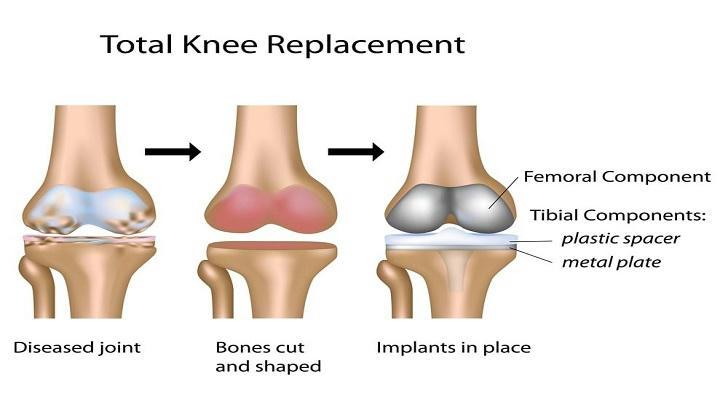Regaining Vitality: How Knee Replacement Surgery Changes Lives
Knee pain, especially that caused by arthritis or long-term wear and tear, can severely affect people's quality of life. From simple walking to complex daily activities, pain and stiffness limit many people's ability to enjoy life. However, with the advancement of medical technology, knee replacement surgery has brought hope to these patients. This article will explore how knee replacement surgery changes the lives of patients and helps them regain their vitality.

The Basic Principle of Surgery
Knee replacement surgery, also known as knee arthroplasty, is a surgical procedure that involves removing the damaged joint and replacing it with an artificial prosthesis to restore joint function. This surgery is typically suitable for patients who have severe joint pain and functional impairments affecting their daily lives. The purpose of the surgery is to relieve pain, improve joint mobility, and thereby enhance the patient's quality of life.
Improvement in Quality of Life
1.Pain Relief: For patients with severe knee pain, particularly due to arthritis or long-term wear and tear, knee replacement surgery can effectively alleviate pain.
2.Improved Function: The surgery can restore normal movement of the knee joint, allowing patients to move more freely in their daily activities, such as walking, climbing stairs, bending, and lifting objects.
3.Enhanced Quality of Life: Reducing pain and improving function can significantly enhance the quality of life, allowing patients to participate more actively in family, social, and recreational activities.
4.Better Sleep Quality: Knee pain often disrupts sleep. By reducing pain, knee replacement surgery can improve sleep quality.

Tips for a fast postoperative recovery
1.The importance of early activity
Early activity can help patients avoid complications caused by prolonged bed rest, such as deep vein thrombosis. Even simple range of motion and short walks can help promote blood circulation, reduce swelling, and maintain joint mobility.
2.Follow a physical therapy plan
Physical therapists will develop a personalized rehabilitation plan for patients, including a series of exercises designed to strengthen muscle strength, improve joint mobility and stability. These exercises help patients regain confidence and improve walking and balance.
3.Rational use of medication
Doctors may prescribe painkillers to control postoperative pain, but patients should take them as directed and avoid overdose. In addition, patients can consider using ice or elevating the affected limb to reduce swelling and pain.
4.Nutrition and diet
Patients should make sure to consume enough protein, vitamins, and minerals to promote wound healing and tissue repair. It is also important to stay hydrated to avoid dehydration that affects wound healing and the overall function of the body.
5.Psychological support
A positive attitude and optimistic expectations have been shown to speed up the recovery process.
How to Choose the Right Doctor and Hospital
Choosing the Right Doctor:
- A surgeon who focuses on knee replacements will have a deeper understanding of the anatomy and the latest techniques in the field.
- Look for board-certified orthopedic surgeons with a proven track record in performing knee replacements.
- Patient testimonials and surgeon reputation within the medical community can also serve as valuable indicators of a surgeon's competence.
Selecting the Right Hospital:
- It's advisable to choose a facility that specializes in joint replacement surgeries and has a multidisciplinary team of healthcare professionals, including anesthesiologists, nurses, and physical therapists.
- The hospital's infection control rates, surgical outcomes, and patient satisfaction scores are important factors to consider.
- The availability of advanced equipment and postoperative rehabilitation services should be taken into account.
Knee replacement success stories
1.John is a 67-year-old retired engineer who enjoys hiking and biking. However, severe osteoarthritis in both knees made it increasingly difficult for him to enjoy his favorite activities. After consulting with an orthopedic specialist and considering all nonsurgical options, John decided to undergo knee replacement surgery. Postoperatively, John followed his rehabilitation plan carefully, and two years later, John continues to enjoy an active lifestyle free of the knee pain that once limited his activities.
2.Susan is a 58-year-old grandmother whose knee pain made it difficult for her to keep up with her young grandchildren. Her knee replacement surgery was a big decision, but it has greatly improved her quality of life. She attended all of her physical therapy sessions and worked hard on strength and flexibility exercises. Her efforts paid off, and she was soon able to play with her dog and dance at her granddaughter's wedding, pain-free activities she had always dreamed of.
Conclusion
Knee replacement surgery is a life-changing procedure that offers those suffering from severe knee pain and functional impairment the opportunity to regain their vitality. By alleviating pain, improving joint mobility, and enhancing the quality of life, knee replacement surgery allows patients to re-engage in activities they love and enjoy a more active lifestyle. Although postoperative recovery requires time and effort, for those patients who are suitable for the surgery, the process is usually worthwhile. With the continuous advancement of medical technology, knee replacement surgery will continue to provide patients with a better quality of life and a brighter future.
